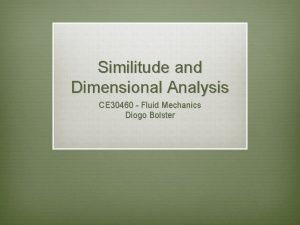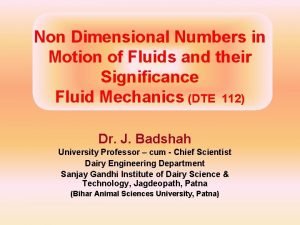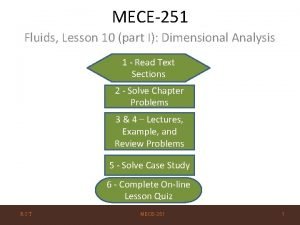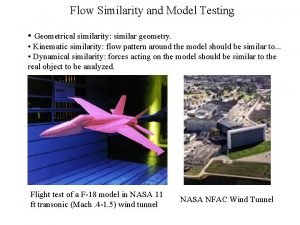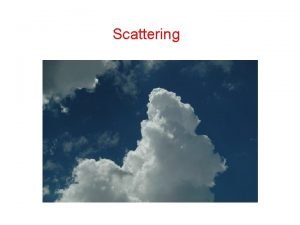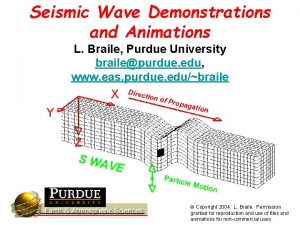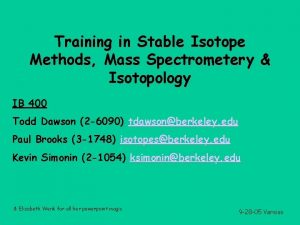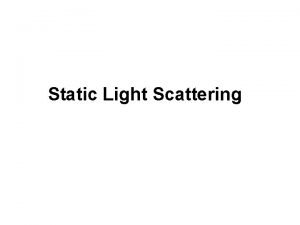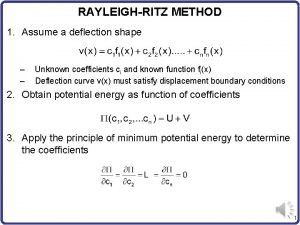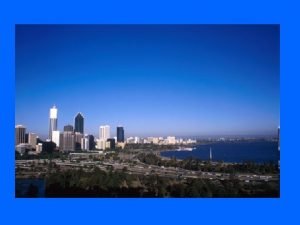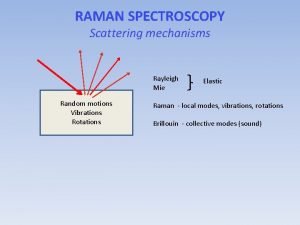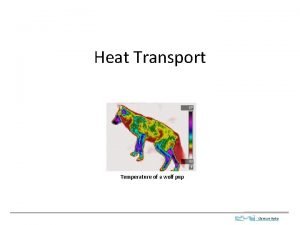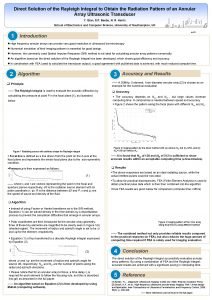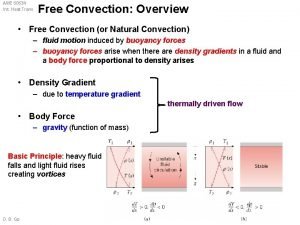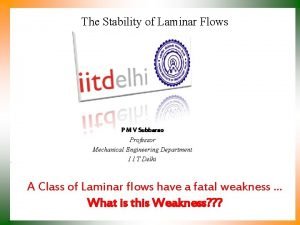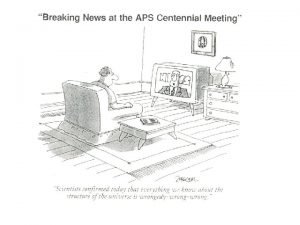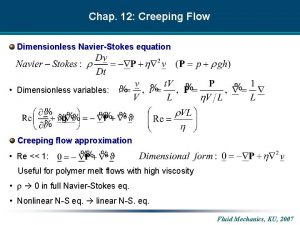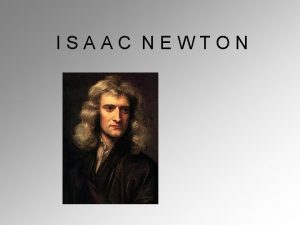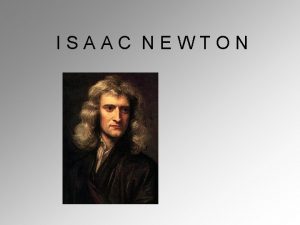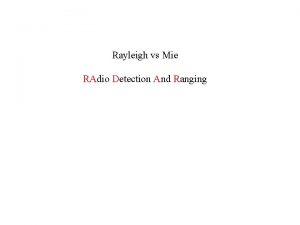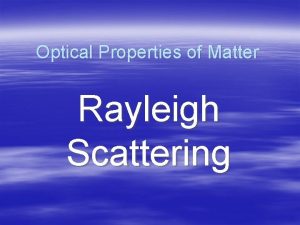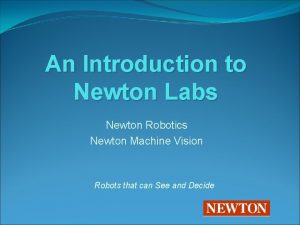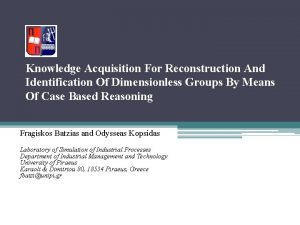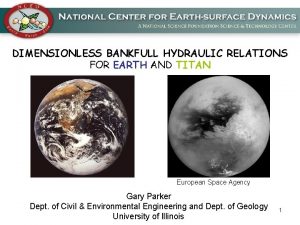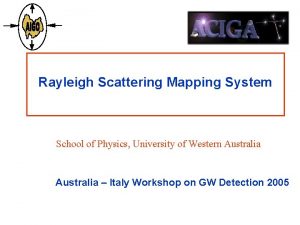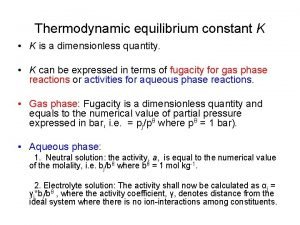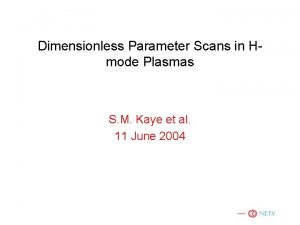From Newton to Rayleigh Physics and Dimensionless Terms





















- Slides: 21

From Newton to Rayleigh: Physics and Dimensionless Terms Characterizing Orbits and Dynamic-soaring Flight Mechanics J. Philip Barnes 11 Nov 2016 1

Presentation Contents • Introduction to non-dim. params. • Rayleigh’s “free exponent” method – Synthesize params. : empirical study – Application: Wing aerodynamic lift • Newton’s conic-section orbits – Tangent: Isaac Newton chronology – Theoretical derivation of params. – Tangent: Lunar free-return trajectory Wellcome Library, London • Application of Newton’s dynamics – “By-inspection” params. to add insight – Applied: Dynamic-soaring trajectory Non-dimensional Parameters in Our Physical World J. Philip Barnes Nov 2016 2

Introduction to Non-dimensional Parameters • Compact characterization of physical phenomena – Test matrix growth is exponential w/each new variable • Avoid “Mars Lander” mixed and/or ambiguous units • Added insight, i. e. , “thrust/weight” or “lift/drag” ratio • Non-dimensional quotient, 2 or more variables, i. e. p ≡ C/D • Another well-known example: Reynolds number ≡ rvc/m – fluid density (r), velocity (v), length (c), & viscosity (m) • Myriad applications (some below included herein): – Motor-generator torque, speed, & current 1 – Origin of wing aerodynamic lift coefficient – Conic-orbital position, velocity, and time 2 – Gear geometry, mesh loss, & windage 3 – Dynamic-soaring flight mechanics 4 – Heat transfer 3, tribology, . . . 1 2 3 4 Barnes, J. P. , AIAA 2016 -4711, Principles of High-efficiency Electric Flight, 2016 AAS 87 -537, Relating Conic-section Orbital Position, Velocity and Time From Periapsis as Dimensionless Quantities, 1987 AGMA 97 FTM 11, Non-dimensional Characterization of Gear Geometry, Mesh Loss, and Windage (see also Appendix), 1997 SAE 2004 -01 -3088, How Flies the Albatross - the Flight Mechanics of Dynamic Soaring, 2004 Non-dimensional Parameters in Our Physical World J. Philip Barnes Nov 2016 3

Presentation Contents • Introduction to non-dim. params. • Rayleigh’s “free exponent” method 5 – Synthesize params. : empirical study – Application: Wing aerodynamic lift • Newton’s conic-section orbits – Tangent: Isaac Newton chronology – Theoretical derivation of params. – Tangent: Lunar free-return trajectory • Application of Newton’s dynamics – “By-inspection” params. to add insight – Applied: Dynamic-soaring trajectory 5 Lord Rayleigh, Nature, Vol. 95, p. 66, 1915 Non-dimensional Parameters in Our Physical World J. Philip Barnes Nov 2016 4

Rayleigh’s “free-exponent” dimensional analysis Application: Empirical study of wing aerodynamic lift Assume lift (L) depends on angle of attack (a), sweep (L), air density (r), airspeed (v), span (b), air viscosity (m), speed of sound (a), and average chord (c). Angle of attack and sweep are already dimensionless, “embedded” for now into eo. Solve for the “auxiliary” exponents (x) which, together with “free exponents” (e), obtain the dimensions of lift, and which have a non-singular matrix representing their units as follows: L c a b unit r v b m a c L Kg 1 0 0 1 m -3 1 1 -1 1 s 0 -1 -1 0 -2 Non-dimensional Parameters in Our Physical World J. Philip Barnes Nov 2016 5

Rayleigh’s “free-exponent” dimensional analysis, continued 1 Application: Empirical study of wing aerodynamic lift To ensure dimensional consistency, arrange all exponents in a set of equations, one for each applicable unit (kg, meter, sec): kg: m: s: ( 1) e 1 +( 0) e 2 +(0) e 3 + ( 1) x 1 + ( 0) x 2 +(0) x 3 = 1 (-3) e 1 +( 1) e 2 +(1) e 3 + (-1) x 1 + ( 1) x 2 +(1) x 3 = 1 ( 0) e 1 +(-1) e 2 +(0) e 3 + (-1) x 1 + (-1) x 2 +(0) x 3 = -2 Re-write as [A] [x] = [B] to solve for auxiliary exponents [x]: 1 0 0 x 1 = 1 - e 1 -1 1 1 x 2 = 1 + 3 e 1 - e 2 - e 3 -1 -1 0 x 3 = -2 + e 2 x 1 a b Invert [A] and write [x]=[A-1][B]: 1 0 0 x 2 = -1 0 -1 1 + 3 e 1 - e 2 - e 3 =1 + e 1 - e 2 x 3 1 -2 + e 2 1 + e 1 - e 3 2 c L 1 - e 1 1 Non-dimensional Parameters in Our Physical World J. Philip Barnes Nov 2016 6

Rayleigh’s “free-exponent” dimensional analysis, continued 2 Application: Empirical study of wing aerodynamic lift Recall the original assertion: Recall from the previous slide: x 1 1 - e 1 x 2 = 1 + e 1 - e 2 x 3 c 1 + e 1 - e 3 Therefore, now re-introducing angle of attack (a), formerly “embedded” in eo which now “floats” to a new value: L a b Putting full trust in this result, now take test data; vary (r, v, m, a), etc. Predict the exponents e 1 e 2 e 4 We find empirically: L ~ V 2 a Non-dimensional Parameters in Our Physical World J. Philip Barnes Nov 2016 7

Rayleigh’s “free-exponent” dimensional analysis, continued 3 Application: Empirical study of wing aerodynamic lift The system previously described is arguably workable, but our measurements reveal lift as proportional to density, wing area, and the square of velocity. Let’s now implement some manipulations at our disposal. We can swap two parameters of the same units, divide the equation by any or all parameters, and multiply any parameter by, for example, (v/v) to split it into two groups, one pre-existing. Swap (a, v) ; then divide by (1/2) [rvc/m] [b/c]: e 3 Lift coefficient Reynolds number 1/Mach Aspect Ao. A number ratio For Mach<<1, predict the exponent e 2 Non-dimensional Parameters in Our Physical World J. Philip Barnes Nov 2016 8

Presentation Contents • Introduction to non-dim. params. • Rayleigh’s “free exponent” method – Synthesize params. : empirical study – Application: Wing aerodynamic lift • Newton’s conic-section orbits – Tangent: Isaac Newton chronology – Theoretical derivation of params. – Tangent: Lunar free-return trajectory • Application of Newton’s dynamics – “By-inspection” params. to add insight – Applied: Dynamic-soaring trajectory Non-dimensional Parameters in Our Physical World J. Philip Barnes Nov 2016 9

Conic-section orbits: Isaac Newton Chronology Year 1665 1666 1668 1672 1684~ 1685 1686 1702 1708 1727 Age 23 23 24 26 30 43 44 60 66 85 Development or Event Trinity math degree, avoids plague Invents differential calculus 6 Integral calculus & gravitation Cambridge faculty appointment Elected Royal Society Fellow Leibniz publishes his own calculus 7 Sphere point-mass equivalent 8 Principia (all proofs geometric) Optix (1 st pub. Newton’s calculus) Knighted Quoted, shortly before death: “I do not know what I may appear to the world, but to myself I seem to have been only like a boy playing on the seashore, and diverting myself in now and then finding a smoother pebble or a prettier shell than ordinary, while the great ocean of truth lay all undiscovered before me. ” 6 7 8 Gamow, G. , The Great Physicists From Galileo to Einstein, Dover, 1988 Jardine, L. , Ingenious Pursuits, Building the Scientific Revolution, Anchor, 2000 Singer, C. , A Short History of Science to the Nineteenth Century, Dover 1997 Non-dimensional Parameters in Our Physical World J. Philip Barnes Nov 2016 10

Conic-section orbits: From Principia to the present day “. . . if any body is acted upon by a. . . force that is inversely proportional to the square of the distance. . . from the center, this body will move in. . . one of the conics having a focus in the center of forces. ” e≡SB/BK =SC/CL Conic section, Principia, Book 1, Section 4, 1686 Newton, Principia, Book 1, Sect. 3, 1686 Symbols and Definitions m Product of central mass (M) & universal gravitational constant (G) r Radius from the central body center to the satellite q True anomaly (angle from closest passage) v Satellite velocity relative to the central body g Flight path angle (see sketch) h Angular momentum per unit satellite mass t Time from periapsis (closest passage) e Total kinetic & potential energy per unit satellite mass e Eccentricity of conic section (italic Vs. natural-log base, e) Non-dimensional Parameters in Our Physical World J. Philip Barnes Nov 2016 11

Conic-section orbits: Dimensional & non-dimensional terms W. T. Thomson, Introduction to Space Dynamics, Dover, 1986, p. 73 T= [1/(2 p)] e T= [1/(2 p)] Non-dimensional Parameters in Our Physical World J. Philip Barnes Nov 2016 12

Conic-section orbits: Shape, velocity, and time Vs. position Non-dim. velocity elliptical orbits Conic section orbital shapes vh/m qo Non-dim. velocity hyperbolic orbits vh/m Non-dim. time all conic orbits qo Expedited solution of Kepler’s Problem qo tm 2/(2 ph 3) Non-dimensional Parameters in Our Physical World J. Philip Barnes Nov 2016 13

Conic-section orbits: Lunar free-return trajectory, 1 of 2 After translunar injection at point (1) the spacecraft coasts in a highly-elliptical orbit to the lunar sphere of influence at point (2), where the spacecraft enters a hyperbolic trajectory relative to the moon. If the lunar orbit insertion burn at point (3) fails, the lunar freereturn trajectory returns the spacecraft to earth with the same as outbound-orbital eccentricity and energy. ea rth 16. 9 -hr from 2: 3 ius 2 at TL 3 -hr launch window 300 -km park. orbit 6 -min TLI burn I 3 b ad LOI Grumman: LM TRW: LMDE nr a oo -m Lunar SOI 2. 58 days to lu nar SOI 1 4 Hyperbolic passage as moon travels a : 3 : b Non-dimensional Parameters in Our Physical World J. Philip Barnes Nov 2016 14

Conic-section orbits: Lunar free-return trajectory, 2 of 2 - Computer code variable names include what relative to what, at what point, and with what units, if any. - Carry & share non-dimensional counterparts to help avoid “Mars Lander” Imperial vs. metric unit scenario esm = 1. 69 vme 2_kms vsm 2_kms 3 2 vse 1_kms = 10. 9 vse 2_kms = 0. 78 ese = 0. 972 Vse 1 = 1. 97 1 “Failure is not an option” -Gene Kranz, Apollo 13 Flight Director Non-dimensional Parameters in Our Physical World J. Philip Barnes Nov 2016 15

Presentation Contents • Introduction to non-dim. params. • Rayleigh’s “free exponent” method – Synthesize params. : empirical study – Application: Wing aerodynamic lift • Newton’s conic-section orbits – Tangent: Isaac Newton chronology – Theoretical derivation of params. – Tangent: Lunar free-return trajectory • Application of Newton’s dynamics – “By-inspection” params. to add insight – Applied: Dynamic-soaring trajectory Non-dimensional Parameters in Our Physical World J. Philip Barnes Nov 2016 16

Dynamic Soaring “The albatross…manages to remain master of its own course, either carried. . . around the globe or. . . against the strong winds without a beat of its wings. ” -- Jacques Cousteau “The albatross can maintain this swooping soaring flight for hours on end without a single wing beat. ” -- David Attenborough / 6 X ar e y Wandering Albatross Author’s photo, 2007

Dynamic Soaring ~ Quantifying Rayleigh’s description Dynamic Soaring Force Vector (F) F = m(dw/dt), directed upwind f L Dynamic Soaring Thrust , T = F∙V V D g y w mw T = m (d. V/dt) = m (dw/dt) (d. V/dw) = m (dw/dt) cosg cosy = m (dw/dz) (dz/dt) cosg cosy = m w’ V sing cosy T/W = w’ (V/g) sing cosy mg “. . . energy at the disposal of the bird depends on his velocity relatively to the air. ” “. . . it is only necessary. . . to descend. . . to leeward, and. . . ascend. . . to windward. ” - Rayleigh, The Soaring of Birds, Nature, Vol. 27, Apr. 1883 J. Philip Barnes www. How. Flies. The. Albatross. com Wellcomeimages. org

Three orthogonal accelerations ~ Newton’s Principia Applied “. . . suppose a polygon. . . a body moving with a given velocity along the sides is reflected at each of the angles. . the force will be as that velocity. . . and the number of reflections jointly. ” Loop Radius g V V g Newton, Principia, Book 1, Sect. 2, 1686 Vcosg Vg [Vcosg]y v y w a a=wv Turn Radius J. Philip Barnes www. How. Flies. The. Albatross. com

Equations of motion ~ Dynamic soaring trajectory analysis 1 1: Normal load factor Thrust group 2 Drag group 2: Dimensionless drag 3: Tangent. load factor 3 4: Heading rate 5: Lift coefficient 4 6: Drag-to-lift ratio 7: Trajectory 5 CL = nn W / (½ 6 D/L (CDo /CL ) + CL /(3 A) 7 V 2 S) x = w – V cosg cosy downwind y = V cosg siny crosswind z = V sing vertical Schedule any two angles, say g(t) & y(t) ; get dg/dt, dy/dt Eqns. yield all other parameters J. Philip Barnes www. How. Flies. The. Albatross. com

Schedules, g(t) & y(t) E/g, m v, m/ s /s z, m m w, 2. 9 m/s net progress against 13 m/s wind J. Philip Barnes www. How. Flies. The. Albatross. com June 2015
 Dimensionless groups in fluid mechanics
Dimensionless groups in fluid mechanics Non dimensional numbers
Non dimensional numbers Dimensionless groups in fluid mechanics
Dimensionless groups in fluid mechanics Dimensionless groups in fluid mechanics
Dimensionless groups in fluid mechanics Aortic valve dimensionless index
Aortic valve dimensionless index Like terms and unlike terms in polynomials
Like terms and unlike terms in polynomials Combining like terms definition
Combining like terms definition Brightness and contrast
Brightness and contrast Love and rayleigh waves animation
Love and rayleigh waves animation Sublime gracia
Sublime gracia Rayleigh distillation
Rayleigh distillation How to plot zimm plot in excel
How to plot zimm plot in excel In rayleigh ritz method the deflection curve is assumed as
In rayleigh ritz method the deflection curve is assumed as Rayleigh scattering
Rayleigh scattering Mie scattering vs rayleigh
Mie scattering vs rayleigh Diffusion de rayleigh
Diffusion de rayleigh Rayleigh number
Rayleigh number Rayleigh integral
Rayleigh integral Trans ame
Trans ame What is this
What is this Rayleigh dissipation function
Rayleigh dissipation function Rayleigh theory of light scattering
Rayleigh theory of light scattering
